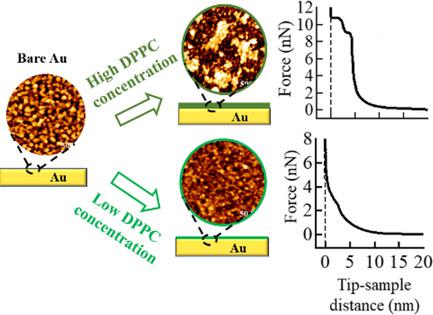当前位置:
X-MOL 学术
›
Phys. Status Solidi A
›
论文详情
Our official English website, www.x-mol.net, welcomes your feedback! (Note: you will need to create a separate account there.)
Solvent-Assisted Lipid Bilayer Formation on Au Surfaces: Effect of Lipid Concentration on Solid-Supported Membrane Formation
Physica Status Solidi (A) - Applications and Materials Science ( IF 2 ) Pub Date : 2020-12-29 , DOI: 10.1002/pssa.202000662 Shova Neupane 1 , Kai Betlem 2 , Frank Uwe Renner 1 , Patricia Losada-Pérez 2
Physica Status Solidi (A) - Applications and Materials Science ( IF 2 ) Pub Date : 2020-12-29 , DOI: 10.1002/pssa.202000662 Shova Neupane 1 , Kai Betlem 2 , Frank Uwe Renner 1 , Patricia Losada-Pérez 2
Affiliation

|
Solvent-assisted lipid bilayer (SALB) formation is emerged as a versatile approach in forming supported lipid membranes (SLBs) on metal surfaces, interesting platforms for transducing a biological signal to an electrical readout where vesicle rupture is not straightforward. Herein, the effect of the lipid concentration in the organic solvent, a key parameter controlling SALB, is addressed in the low and high concentration limits of 1,2-dipalmitoyl-sn-glycero-3-phosphocholine lipid on a Au surface. Quartz crystal microbalance with dissipation (QCM-D) responses are correlated with atomic force microscopy (AFM) topographic and nanomechanical measurements. Upon SALB completion at both concentrations, QCM-D and AFM topographical characterization suggest the formation of thin, although incomplete, lipid layers at the Au–liquid interface, with frequency and dissipation plateau values departing from well-established homogeneous SLB responses. Nanomechanical analysis reveals the presence of mostly monolayers at low concentration due to lack of lipid material, while at high concentration excess of lipid material leads to the coexistence of diverse structures. Their formation stems from the SALB formation mechanism, based on lyotropic transformations upon solvent exchange, which differs from customarily vesicle rupture. Such mechanism leads to peculiar two-step features in approach force curves on SLBs pointing toward a decoupling in bilayer leaflets when supported.
中文翻译:

金表面上的溶剂辅助脂质双层形成:脂质浓度对固体支持膜形成的影响
溶剂辅助脂质双层 (SALB) 的形成是一种在金属表面形成支撑脂质膜 (SLB) 的通用方法,这是将生物信号转换为电读数的有趣平台,其中囊泡破裂并不简单。在此,有机溶剂中脂质浓度的影响是控制 SALB 的关键参数,在 Au 表面上 1,2-二棕榈酰-sn-甘油-3-磷酸胆碱脂质的低和高浓度限制中得到解决。具有耗散 (QCM-D) 响应的石英晶体微天平与原子力显微镜 (AFM) 形貌和纳米力学测量相关。在两种浓度下完成 SALB 后,QCM-D 和 AFM 地形表征表明在 Au-液体界面形成了薄但不完整的脂质层,频率和耗散平台值偏离完善的同质 SLB 响应。纳米力学分析表明,由于缺乏脂质材料,在低浓度下主要存在单层,而在高浓度下,脂质材料过量导致多种结构共存。它们的形成源于 SALB 形成机制,基于溶剂交换时的溶致转化,这与通常的囊泡破裂不同。这种机制导致 SLB 上的接近力曲线中的特殊两步特征指向双层小叶中的解耦。而在高浓度下,过量的脂质材料会导致不同结构的共存。它们的形成源于 SALB 形成机制,基于溶剂交换时的溶致转化,这与通常的囊泡破裂不同。这种机制导致 SLB 上的接近力曲线中的特殊两步特征指向双层小叶中的解耦。而在高浓度下,过量的脂质材料会导致不同结构的共存。它们的形成源于 SALB 形成机制,基于溶剂交换时的溶致转化,这与通常的囊泡破裂不同。这种机制导致 SLB 上的接近力曲线中的特殊两步特征指向双层小叶中的解耦。
更新日期:2020-12-29
中文翻译:

金表面上的溶剂辅助脂质双层形成:脂质浓度对固体支持膜形成的影响
溶剂辅助脂质双层 (SALB) 的形成是一种在金属表面形成支撑脂质膜 (SLB) 的通用方法,这是将生物信号转换为电读数的有趣平台,其中囊泡破裂并不简单。在此,有机溶剂中脂质浓度的影响是控制 SALB 的关键参数,在 Au 表面上 1,2-二棕榈酰-sn-甘油-3-磷酸胆碱脂质的低和高浓度限制中得到解决。具有耗散 (QCM-D) 响应的石英晶体微天平与原子力显微镜 (AFM) 形貌和纳米力学测量相关。在两种浓度下完成 SALB 后,QCM-D 和 AFM 地形表征表明在 Au-液体界面形成了薄但不完整的脂质层,频率和耗散平台值偏离完善的同质 SLB 响应。纳米力学分析表明,由于缺乏脂质材料,在低浓度下主要存在单层,而在高浓度下,脂质材料过量导致多种结构共存。它们的形成源于 SALB 形成机制,基于溶剂交换时的溶致转化,这与通常的囊泡破裂不同。这种机制导致 SLB 上的接近力曲线中的特殊两步特征指向双层小叶中的解耦。而在高浓度下,过量的脂质材料会导致不同结构的共存。它们的形成源于 SALB 形成机制,基于溶剂交换时的溶致转化,这与通常的囊泡破裂不同。这种机制导致 SLB 上的接近力曲线中的特殊两步特征指向双层小叶中的解耦。而在高浓度下,过量的脂质材料会导致不同结构的共存。它们的形成源于 SALB 形成机制,基于溶剂交换时的溶致转化,这与通常的囊泡破裂不同。这种机制导致 SLB 上的接近力曲线中的特殊两步特征指向双层小叶中的解耦。


























 京公网安备 11010802027423号
京公网安备 11010802027423号